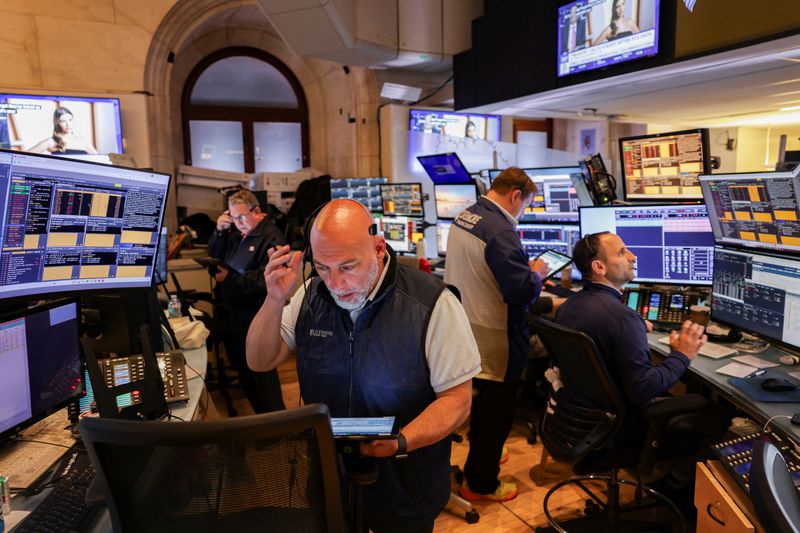Select Language

U.S. stock futures point sharply lower on Friday as investors react to an ratcheting up in tensions in the Middle East. Israel carries out large‑scale airstrike on Iran early Friday which hit “dozens” of military and nuclear targets, sending oil prices soaring. Elsewhere, the search continues for missing people after a fatal Air India crash that led to a decline in shares in Boeing (NYSE:BA) and other jet suppliers.
1. Futures drop
U.S. stock futures slumped, while oil prices surged, after Israel carried out a military strike on Iran.
By 03:45 ET (07:45 GMT), the Dow futures contract had fallen by 449 points, or 1.3%, S&P 500 futures had dropped by 83 points, or 1.4%, and Nasdaq 100 futures had shed 318 points, or 1.5%.
The prospect of escalating tensions in the Middle East -- a critical hub for oil production -- added to uncertainty for investors already grappling with heightened trade tensions that some fear could dent global growth.
Still, global stocks have posted an near-continuous rally since early April, with traders largely hoping that President Donald Trump’s tariff agenda may not be as aggressive as originally thought. Following relatively benign consumer and producer price reports for May this week, equities on Wall Street gained on Thursday.
2. Oil spikes after Israel strikes Iran
Oil prices surged on Friday in the wake of Israel’s large‑scale airstrike on Iran early Friday, which hit “dozens” of military and nuclear targets, according to media reports.
"Following the preemptive strike by the State of Israel against Iran, a missile and UAV (drone) attack against the State of Israel and its civilian population is expected in the immediate timeframe," Defence Minister Israel Katz said in a statement.
At 03:02 ET, Brent futures climbed 5.7% to $73.32 a barrel and U.S. West Texas Intermediate crude futures rose 6% to $72.13 a barrel. Both contracts hit their highest in almost five months, as traders worried that any conflict could disrupt shipping routes or oil infrastructure across the Gulf.
Reacting to a potential elevation in geopolitical risk, investors also shifted into perceived safe-haven assets like gold and the Swiss franc. The yield on the 10-year U.S. Treasury note, which moves inversely to prices, fell to a one-month low as well.
Iran launched around 100 drones towards Israeli territory in response, an Israeli military spokesman said. Sirens and a state of emergency were declared across Israel amid warnings of an imminent missile and drone counter‑strike from Tehran.
Iran’s state media confirmed reports saying that the strikes had killed Iran’s Revolutionary Guards Commander Hossein Salami, along with six nuclear scientists.
3. Air India crash latest; Boeing slides
Shares in Boeing lost more than 4% on Thursday, following a deadly crash of an Air India flight heading to London’s Gatwick Airport.
Over 240 people were killed in the accident, Reuters reported, adding that rescue workers are continuing to search for missing people and aircraft parts.
The plane -- a Boeing 787-8 Dreamliner carrying some 242 people -- crashed shortly after take-off from Ahmedabad in western India, in the world’s worst aviation disaster in years.
One person survived after the jet crashed into a medical college hostel in Ahmedabad, causing dozens of deaths on the ground.
GE Aerospace (NYSE:GE), whose GEnx-1B engines power the 787 Dreamliner, and Spirit AeroSystems (NYSE:SPR) also saw their share prices decline following the crash.
4. Adobe (NASDAQ:ADBE) results
Adobe raised its annual guidance after reporting better-than-expected fiscal second-quarter revenue, as its core digital media business continued to ride an artificial intelligence-led demand wave.
For 2025, the company upgraded its guidance for adjusted per-share income to between $20.50 to $20.70 on revenue of $23.50 billion to $23.60 billion, up from a prior range for adjusted EPS of $20.20 to $20.50, and revenue of $23.30 billion to $23.55 billion.
Digital media segment revenue is now expected to come in at between $17.45 billion and $17.50 billion, up from $17.25 billion to $17.40 billion previously.
The Photoshop-owner reported second-quarter revenue of $5.87 billion, topping analysts’ average estimates of $5.8 billion.
But shares in the company edged slightly lower in after-hours trading on Friday. Analysts at Vital Knowledge flagged that while investors "should come away relatively happy" with Adobe’s returns, its outlook "isn’t nearly as impressive" as cloud-computing group Oracle (NYSE:ORCL), which reported earlier this week.
5. University of Michigan sentiment ahead
Highlighting the economic calendar on Friday will be the University of Michigan’s survey tracking consumer sentiment and inflation expectations.
Economists anticipate that the survey, which has shown signs of deterioration in recent months as Americans fret over the impact of Trump’s tariffs, will recover somewhat in June.
"That would still leave it at a relatively subdued level, reflecting the still elevated inflation expectations component," analysts at ING said in a note to clients.
One-year inflation rate expectations are tipped to come in at 6.4%.
Data this week has shown that overall price pressures in the U.S. were broadly contained in May, although analysts have flagged lingering concerns that the effect of Trump’s tariffs has yet to be fully felt.

